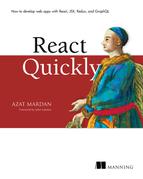Foreword
I keep hoping that JavaScript will die. Seriously. Die brutally and painfully.
It’s not that I completely dislike JavaScript—it has improved quite a bit over the years. It’s that I have a severe distaste for complexity—so much so that I named my blog and my business Simple Programmer. My tagline has always been, “Making the complex simple.”
Making the complex simple isn’t easy. It takes a special set of skills. You have to be able to understand the complex, and understand it so well that you can distill it down to the core—because everything is simple at the core. This is exactly what Azat has done with this book, React Quickly.
Now, I’ll admit Azat had a little help. You see, one of the reasons I personally like ReactJS so much is that it’s simple. It was designed to be simple. It was designed to deal with the increasing complexity of JavaScript frameworks and reduce that complexity by going back to the basics: plain old JavaScript. (At least, for the most part. ReactJS does have a JSX language that’s compiled into JavaScript, but I’ll let Azat tell you about that.)
The point is, although I like Angular, Backbone, and some other JavaScript frameworks because they’ve helped make it much easier for web developers to create asynchronous web applications and single-page applications, they’ve also added a great deal of complexity. Using templates and understanding the syntax and subtleties of these frameworks increased productivity, but they moved the complexity from the backend to the frontend. ReactJS starts over, gets rid of templates, and gives you a way to apply component-based architecture to your UI using JavaScript. I like this. It’s simple. But even the simplest thing can be difficult to explain—or worse yet, made complex by a teacher who lacks this skill.
This is where Azat comes in. He knows how to teach. He knows how to simplify. He begins this book by explaining React through contrasting it with something you probably already know: Angular. Even if you don’t know Angular, his explanation of ReactJS will quickly help you understand the basics and its purpose. Then Azat quickly demonstrates how to create a basic ReactJS application, so you can see and do it for yourself. After that, he takes you through the 20% you need to know in order to accomplish 80% of what you’ll do in React, using real-world examples that anyone can grasp easily. Finally—and this is my favorite part—he includes examples and projects galore. The absolute best way to learn is by doing, and Azat walks you through creating six—yes, six—nontrivial projects using ReactJS.
In keeping with my theme of simplicity, I’ll leave off here by saying that React Quickly is simply the best way I know of to learn ReactJS.
JOHN SONMEZ
AUTHOR OF Soft Skills (http://amzn.to/2hFHXAu)
AND FOUNDER OF Simple Programmer (https://simpleprogrammer.com)
